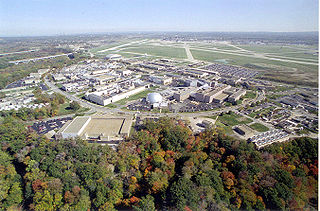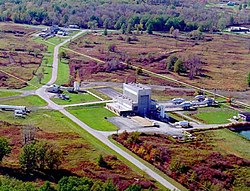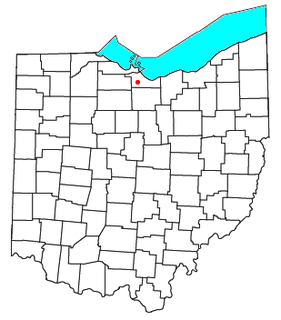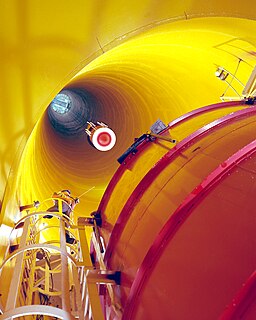
An ion thruster or ion drive is a form of electric propulsion used for spacecraft propulsion. It creates thrust by accelerating positive ions with electricity. The term refers strictly to gridded electrostatic ion thrusters, and is often incorrectly loosely applied to all electric propulsion systems including electromagnetic plasma thrusters.

The Ames Research Center (ARC), also known as NASA Ames, is a major NASA research center at Moffett Federal Airfield in California's Silicon Valley. It was founded in 1939 as the second National Advisory Committee for Aeronautics (NACA) laboratory. That agency was dissolved and its assets and personnel transferred to the newly created National Aeronautics and Space Administration (NASA) on October 1, 1958. NASA Ames is named in honor of Joseph Sweetman Ames, a physicist and one of the founding members of NACA. At last estimate NASA Ames has over US$3 billion in capital equipment, 2,300 research personnel and a US$860 million annual budget.

The George C. Marshall Space Flight Center (MSFC), located in Huntsville, Alabama, is the U.S. government's civilian rocketry and spacecraft propulsion research center. The largest NASA center, MSFC's first mission was developing the Saturn launch vehicles for the Apollo Moon program. Marshall has been the agency's lead center for Space Shuttle propulsion and its external tank; payloads and related crew training; International Space Station (ISS) design and assembly; and computers, networks, and information management. Located on the Redstone Arsenal near Huntsville, Alabama, MSFC is named in honor of Army General George Marshall.

Cape Canaveral Air Force Station (CCAFS) is an installation of the United States Air Force Space Command's 45th Space Wing.

The John C. Stennis Space Center (SSC) is a NASA rocket testing facility. It is located in Hancock County, Mississippi, on the banks of the Pearl River at the Mississippi–Louisiana border. As of 2012, it is NASA's largest rocket engine test facility. There are over 30 local, state, national, international, private, and public companies and agencies using SSC for their rocket testing facilities.

The Nuclear Engine for Rocket Vehicle Application (NERVA) was a U.S. nuclear thermal rocket engine development program that ran for roughly two decades. NERVA was a joint effort of the U.S. Atomic Energy Commission (AEC) and NASA, managed by the Space Nuclear Propulsion Office (SNPO) until both the program and the office ended at the end of 1972.

The RL10 is a liquid-fuel cryogenic rocket engine used on the Centaur, S-IV, and Delta Cryogenic Second Stage upper stages. Built in the United States by Aerojet Rocketdyne, the RL10 burns cryogenic liquid hydrogen and liquid oxygen propellants, with each engine producing 64.7 to 110 kN (14,545–24,729 lbf) of thrust in vacuum depending on the version in use. The RL10 was the first liquid hydrogen rocket engine to be built in the United States, and development of the engine by Marshall Space Flight Center and Pratt & Whitney began in the 1950s, with the first flight occurring in 1961. Several versions of the engine have been flown, with three, the RL10A-4-2, the RL10B-2, and the RL10C-1 still being produced and flown on the Atlas V and Delta IV.
White Sands Test Facility (WSTF) is a U.S. government rocket engine test facility and a resource for testing and evaluating potentially hazardous materials, space flight components, and rocket propulsion systems. NASA established WSTF on the White Sands Missile Range in 1963. WSTF services are available to NASA, the United States Department of Defense, other federal agencies, universities and commercial industry. WSTF is managed by the Lyndon B. Johnson Space Center. WSTF is located in the western foothills of the Organ Mountains, eleven miles east of Las Cruces, New Mexico.

Space Power Facility (SPF) is a NASA facility used to test spaceflight hardware under simulated launch and spaceflight conditions. The SPF is part of NASA's Plum Brook Station, which in turn is part of the Glenn Research Center. The Plum Brook Station and the SPF are located near Sandusky, Ohio.

The Neil Armstrong Operations and Checkout Building is a historic building on Merritt Island, Florida, United States. The five-story structure is in the Industrial Area of NASA's Kennedy Space Center. Its facilities include the crew quarter dormitories for astronauts, and suit-up preparations prior to their flights. The other facility is a large spacecraft workshop used for manufacturing and checking activities on manned spacecraft. On January 21, 2000, it was added to the U.S. National Register of Historic Places.

A rocket engine test facility is a location where rocket engines may be tested on the ground, under controlled conditions. A ground test program is generally required before the engine is certified for flight. Ground testing is very inexpensive in comparison to the cost of risking an entire mission or the lives of a flight crew.

Rocket Engine Test Facility was the name of a facility at the NASA Glenn Research Center, formerly known as the Lewis Research Center, in Ohio. The purpose of the Rocket Engine Test Facility was to test full-scale liquid hydrogen rockets at thrust chamber pressures of up to 2100 psia and thrust levels to at least 20,000 pounds. Work on the design of the facility began in 1954 under the auspices of NACA's Rocket Branch of the Fuels and Combustion Research Division. It was built at a cost of $2.5 million and completed in 1957. The facility was located at the south end of the Center, adjacent to Abrams Creek 41.404°N 81.868°W. It was demolished in 2003 in order to make way for the runway expansion of the Cleveland Hopkins International Airport.

The Redstone Test Stand or Interim Test Stand was used to develop and test fire the Redstone missile, Jupiter-C sounding rocket, Juno I launch vehicle and Mercury-Redstone launch vehicle. It was declared an Alabama Historic Civil Engineering Landmark in 1979 and a National Historic Landmark in 1985. It is located at NASA's George C. Marshall Space Flight Center (MSFC) in Huntsville, Alabama on the Redstone Arsenal, designated Building 4665. The Redstone missile was the first missile to detonate a nuclear weapon. Jupiter-C launched to test components for the Jupiter missile. Juno I put the first American satellite Explorer 1 into orbit. Mercury Redstone carried the first American astronaut Alan Shepard into space. The Redstone earned the name "Old Reliable" because of this facility and the improvements it made possible.
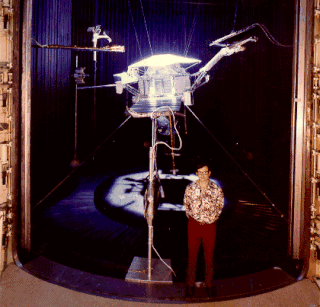
The Twenty-Five-Foot Space Simulator is a chamber designed for testing spacecraft in space-like conditions, including extreme cold, high radiation, and near-vacuum pressure. Built in 1961, it is located at the Jet Propulsion Laboratory in Pasadena, California, and has been used to prepare a large number of American space probes prior to their launches. It was declared a National Historic Landmark in 1985 and is on the National Register of Historic Places.

The Wallops Flight Facility Visitor Center is located in Building J-17, Wallops Island, Virginia, United States along Route 175. It contains exhibits highlighting past missions conducted at NASA's Wallops Flight Facility. The visitor center also provides information about current activities at Wallops Flight Facility, such as the sounding rocket, balloon and aircraft program. The outside grounds has a rocket garden consisting of rockets and aircraft used for space and aeronautical research, including a full-scale four stage reentry vehicle used to study the Earth's atmosphere. In addition, the visitor center has educational programs on Earth and space science. It is also a viewing area for rocket launches.

The Space Environment Simulation Laboratory (SESL) is a facility in Building 32 at the Lyndon B. Johnson Space Center that can perform large-scale simulations of the vacuum and thermal environments that would be encountered in space. Built in 1965, it was initially used to test Apollo Program spacecraft and equipment in a space environment, and continues to be used by NASA for testing equipment. It was designated a National Historic Landmark in 1985.

NASA facilities not only exist across the United States, but also across the world. NASA Headquarters in Washington, DC provides overall guidance and political leadership to the agency. There are 10 NASA field centers, which provide leadership for and execution of NASA's work. These field centers are: Ames (Research), Armstrong, Glenn (Research), Goddard, JPL, Johnson (Space), Kennedy (Space), Langley (Research), Marshall, Stennis (Space). All other facilities fall under the leadership of at least one of these field centers. Some facilities serve more than one application for historic or administrative reasons. NASA has used or supported various observatories and telescopes, and an example of this is the NASA Infrared Telescope Facility. In 2013 a NASA Office of the Inspector General's (OIG) Report recommended a Base Realignment and Closure Commission (BRAC) style organization to consolidate NASA's little used facilities. The OIG determined at least 33 of NASA's 155 facilities were underutilized.
The Plum Brook Reactor was a NASA 60 megawatt water-cooled and moderated research nuclear reactor, located in Sandusky, Ohio, 50 mi west of the NASA Glenn Research Center in Cleveland, of which it was organizationally a part.

